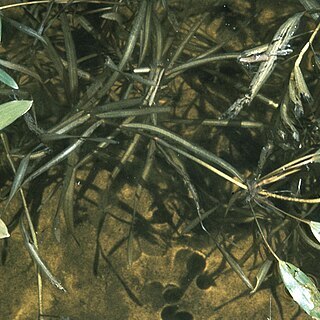Rhizomes present. Cauline stems flattened, without spots, 10--90 cm; glands absent. Turions absent. Leaves both submersed and floating or floating absent, ± spirally arranged. Submersed leaves sessile, lax; stipules persistent, inconspicuous, convolute, free from blade, red-brown, not ligulate, 1--3 cm, not fibrous, not shredding at tip, apex obtuse; blade red-brown to light green, linear, not arcuate, 5--22 cm ´ 1--10 mm, base not clasping, without basal lobes, margins entire, not crispate, apex not hoodlike, blunt to acute, lacunae present, broad band each side of midvein; veins 3--13. Floating leaves petiolate; petioles continuous in color to apex, 2--12.5 cm; blade adaxially light green, narrowly oblong-oblanceolate to elliptic, 2--8 cm ´ 4--20 mm, base acute, apex rounded or bluntly cuspidate; veins 11--41. Inflorescences unbranched, emersed; peduncles not dimorphic, axillary, erect, cylindric, 1.5--5(--16) cm; spikes not dimorphic, cylindric, 0.8--4 cm. Fruits sessile, greenish brown, round-obovoid, flattened, abaxially and laterally keeled, 2.5--4.5 ´ 2--3.6 mm, lateral keels without sharp points; beak erect, 0.5 mm; sides without basal tubercles; embryo with less than 1 full spiral. 2n = 26.
More
Stem slender, somewhat flattened, often branched, to 2 m; rhizomes elongate; lvs sessile, linear, to 2 dm, 2–10 mm wide, 5–13-nerved, the midrib flanked by a pair ofconspicuous bands (each 1–2+ mm wide) of pale green or translucent lacunar cells; stipules 1–3 cm, free; floating lvs usually numerous, linear-elliptic to somewhat spatulate or narrowly obovate, 3–7 cm × 8–20 mm, 11–27-veined, mostly obtuse, narrowed below to a slender petiole about as long as the blade; peduncles about as thick as the stem, 2–5 cm, seldom longer; spikes numerous, cylindric, dense, 1–3 cm; frs obliquely obovoid, 2.5–4 mm, shallowly pitted, the sharp dorsal keel flanked by a pair of lower ones; 2n=26. Ponds and slow streams; Nf. to Que. to s. Alas., s. to Ga., La., and Calif.


